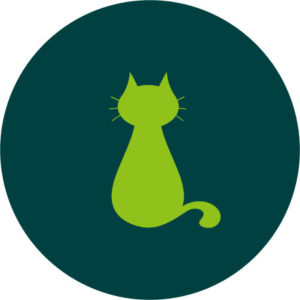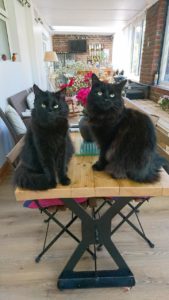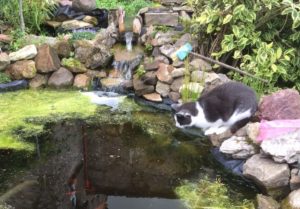
Cat age: 3-6 years
Human equivalent: 28-40 years
These cats are in the prime of their lives. Fully grown and a bit wiser in the way of the world, their curtain-climbing and tail chasing days are probably behind them. They have found their place in the world and are willing to spend considerable time and effort to maintain it. In between naps, of course! Cats of this age are often overlooked in terms of veterinary care as they are generally very healthy but keeping up with regular health checks not only alerts you to any potential issues but also keeps them used to being handled.
Recommended Veterinary Care
| What needs to be done? | How often?* |
| Health check/physical exam | Every 6-12 months |
| Weight check | Every 6-12 months |
| Vaccination | Every 1-3 years according to individual risk assessment |
| Worming | Every 3-12 months as required by lifestyle |
| Flea treatment | Monthly, if you choose to treat, otherwise flea comb monthly |
| Nail trim | Not recommended in cats that go outdoors |
| Blood pressure check | Not required at this age |
| Urine test | Not required at this age |
| Blood test | Not required at this age |
*Please note, recommendations may differ between vets and there isn’t necessarily a right or wrong answer, these are just our suggestions based on our desire to keep our cats safe but avoid over-treatment at the same time!
How You Can Help At Home
Understand their need for consistency and predictability
- Cats of this age start to develop strong routines. You may find that they always go out at a certain time of day, take a certain path around the garden, nap in the same place and expect to be fed at the same time. Cats take great comfort in their routines, and provided everything is as it should be, they can comfortably go about their main business – napping.
- Any break in this routine, however how small and perhaps imperceptible to us humans, can be a source of stress. Even something as simple as adding a new item of furniture or having a friend over for tea may result in undesirable behaviours such as urine marking or scratching. If this occurs, speak with your vet or nurse as there are many ways to help from simple environmental modifications to calming pheromones/supplements.
Understand how they interact with other cats

- Most cats are very good at getting along with (ie, tolerating) their neighbours and housemates and if you really pay attention, you may notice that your cat ‘time shares’ your garden or even parts of your house with other cats.
- Conflict is generally avoided at all costs but when some cats feel that another has broken the rules and come too close, a fight will break out. If your cat is fighting regularly, consider keeping them indoors at night or discuss an official time sharing schedule if you know the owner of the other cat. If the fighting is between cats of the same household, ask your vet/nurse for help or seek the advice of a feline behaviourist.
- For any cat with outdoor access, a microchip-activated cat flap is recommended. This will both allow them freedom of movement but also safe entry back into the house if they find themselves chased by another cat. Microchip cat flaps keep other cats from entering your house, an extremely distressing situation for your cat.
Keep them entertained

- Adult cats still like to play, and are even more prone to put on excess weight so keep up the exercise! Catnip is a great way to get even the most sedentary cat into a more active mood. Puzzle feeders are not only a good way to keep your cat active and slow down their meals but they’re good fun too.
- All cats benefit from an enriched indoor environment including wide, tall and stable scratching posts, catnip toys, feather wand toys, suitable resting places including both enclosed and up high options. For cats without outdoor access, you will have to work a bit harder to provide your cat with the freedom and intellectual stimulation they require. There are many resources online to help with creating a fun indoor environment for all cats including the Indoor Pet Initiative at indoorpet.osu.edu/cats.
Keep them safe
- Be mindful of household hazards and do your best to keep these to a minimum. That means no lilies in the house, full stop! Other common hazards include household cleaners, potpourri, essential oil diffusers, many human foods and all medications.
- Never use topical products on your cat unless specifically recommended by your vet. Medications used on dogs are often not safe for cats, and topical products such as TCP, Germolene, Savlon and tea tree oil can be extremely toxic for cats.
- If your cat wears a collar, make sure it has a safety release.
Feed a high quality, varied diet
- Remember that cats are strict carnivores – they are built to eat other animals or in other words, meat. Although most cats can tolerate grains and starchy foods to some extent, some cannot. Unless your vet has specifically recommended a particular diet for medical reasons, you are generally safe to feed your cat the highest meat content food you can afford and avoid foods with a lot of grains (carbs) or fillers (NOTE – ‘grain-free’ does not necessarily mean high in meat so check the ingredients list carefully).
- In general, wet foods are closer to the natural diet of a cat than dry foods and also help prevent dehydration so they are usually a better choice for the majority of your cat’s diet.
- Make sure most of the food you feed your cat says it is ‘complete and balanced’, as feeding too many ‘complementary’ foods can result in dietary imbalances. Just because a food is complete, however, doesn’t mean they should eat the same food every day for years on end. Do their taste buds and their bodies a favour and mix it up from time to time. If your cat has been on the same food for a long time, make the change gradually to avoid upsetting their tummies. Once they get used to the variety, they will be better off for it.
- Learn which foods your cat prefers and avoid those that regularly cause stomach upset as what works for one cat may not work for another. Just don’t fall into the trap of feeding them just their favourite food all the time, especially if that food is a dry biscuit.
- Meat is the most expensive component of any pet food so unfortunately the best foods for your cat are often the most expensive. Can’t afford top quality cat food 7 days a week? Mix and match, or supplement their diet from time to time with a high quality protein sources such as plain cooked chicken or fish.
- Always make sure your cat has access to fresh water, even if they don’t seem to want to drink it. Cats don’t usually like to eat near where they drink, so separate their food and water dishes.

Monitor their weight
- As
with junior cats, excessive weight gain is common but NOT normal, and can
predispose your cat to serious medical problems like diabetes, heart disease
and arthritis later in life. Although some cats do OK with food on offer all
day, most adult cats require portion control.
- Figure out how much food your cat should be eating on a daily basis to maintain a healthy weight (ask your vet nurse for advice!) and put that aside to feed throughout the day – once that’s gone, that’s it until tomorrow! If they won’t leave you alone, alter your feeding frequency and style, not the quantity fed, or offer catnip or a toy instead.
Good To Know
Cats like to sleep, a lot. Anywhere from 12-20 hours a day depending on their age. Most of that time is spent lightly napping, with ears alert and ready to react if needed, but about a quarter of it is spent in deep sleep. Cats may rapidly move their eyes, twitch their noses, paddle their feet and even snore whilst sleeping, all of which can be normal. Get to know what (and where) is normal for your cat and notify your vet if you notice any changes as this can be an early sign of illness.
When they’re not sleeping or prowling their territory, cats can often be found grooming themselves. Grooming is a healthy behaviour and usually indicates that the cat is relaxed, happy and feeling well. A lack of grooming, the development of matted fur, or excessive grooming resulting in hair loss or trauma to the skin, should be brought to the attention of your vet.
Many adult cats love to hunt. If your cat has outdoor access, be prepared to accept their little ‘gifts’. If this thought terrifies you, keep your cat indoors from dusk till dawn as this is when most hunting occurs.

It is normal and essential for cats to scratch things with their claws in order to keep their nails at a healthy length and as a sign of territory marking, much as they would learn to do in the wild. If you don’t want that ‘thing’ to be your sofa, provide a wide variety of scratching posts of different materials and sizes for your cat to choose from.
It is normal for cats to prefer a varied diet as this natural instinct helps protect them from dietary imbalances. They may happily eat one type of food one day, then turn their nose up at it the next. Don’t get angry or give up, simply put the rest of that variety in the cupboard and try again in a few weeks, chances are they’ll try it again later. If your cat becomes particularly picky with their food however, especially if they regularly vomit or suffer from diarrhoea/constipation, speak with your vet as this is likely a sign of illness.
Many cats may prefer to urinate and defecate outdoors but some prefer the comforts of home. Even if your cat rarely uses a litter tray, it is best to keep one in the house (in a quiet, safe area) so they have the option of using it if needed. Changes in urination/defecation can also indicate health problems so maintaining a litter tray is a great way to keep track of what they are producing.
This guide is based on the AAFP-AAHA Feline Life Stage Guidelines publication, as well as recommendations made by the ISFM CatCareforLife and iCatCare websites – please visit these highly informative websites for additional information.

